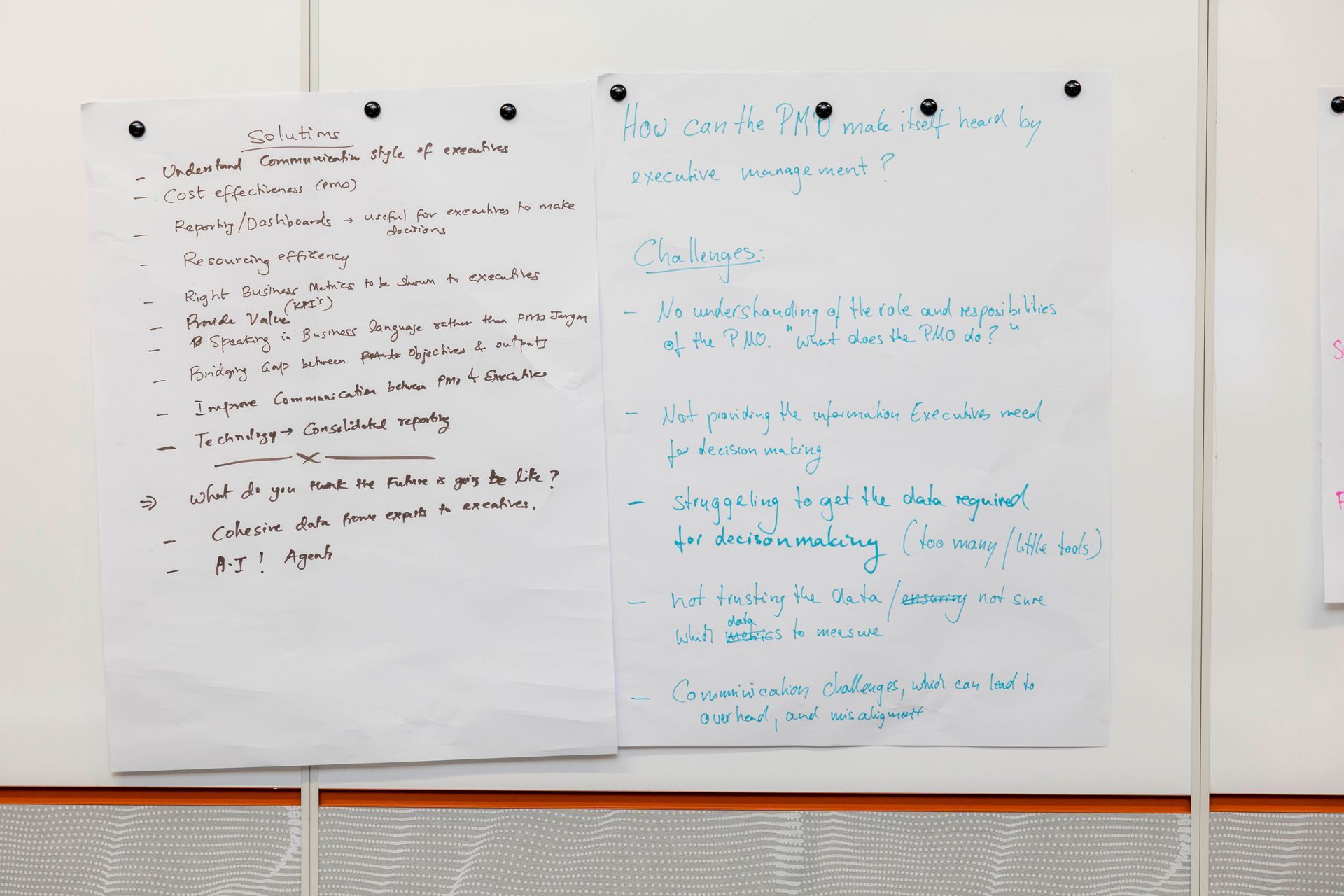27 March 2025
Speaking the Executive Language: How PMOs Can Bridge the Gap

Hearing, Listening, Acting, and Responding Back
For Project Management Offices (PMOs), effective communication with executives is critical. Yet, many PMOs struggle to make their voices heard.
At our event in both Sydney and Melbourne in November 2024, we set out to understand why this was and start to develop solutions to bridge the gap between the PMO and the Executive.
When surveying the room, attendees who were from different part of the business cited the following reasons for struggling to have their voices heard: they often get lost in project details, risk logs, and execution-level complexities, making it difficult for executives to grasp the bigger picture.
When we draw on our own experience with Executives, we know they think in terms of strategy, business outcomes, and financial impact.
If the PMO fails to tailor its messaging accordingly, it risks losing executive buy-in. To truly bridge the communication gap, PMOs must master the art of hearing, listening, acting, and responding in a way that aligns with executive priorities.

Step 1: Hearing – Understanding What Executives Need to Know
Before PMOs can communicate effectively, they must first understand executive priorities. This means actively hearing—not just listening—for cues on what matters most to leadership. Key strategies include:
- Identifying Stakeholder Priorities: Are executives focused on growth, cost reduction, or risk management? Tailor updates accordingly.
- Aligning to Business Strategy: Ensure that PMO reporting links project progress to broader company goals.
- Observing Executive Language: Take note of the terminology and key metrics executives frequently use and incorporate them into PMO communication. The references can be their meetings, the town halls and just chats over coffee break or lunch!
Why not try this...
After an executive meeting, summarise the key points discussed and ask for confirmation to ensure alignment. This might be a great time to incorporate an AI notetaker to assist you in the meeting. If you meet via Microsoft Teams or zoom you can record the meeting and leverage the transcription to create your summary using the Executives own words. Alternatively if you meet in-person, a service such as Otter.ai to notetake.
If you are unable to meet with the executive, listen to your recent company update recordings or read your company's annual reports and line up three main objectives they emphasise for the future. Understand your executives top three priorities and tailor reporting to reflect those.

Step 2: Listening – Engaging in Meaningful Dialogue and take action
Listening goes beyond just hearing what executives say; it requires active engagement. PMOs should:
- Ask the Right Questions: Instead of providing excessive details, ask executives what success looks like for them.
- Encourage Two-Way Communication: Allow for dialogue rather than one-sided reporting.
- Interpret Concerns Beyond Words: Executives may not explicitly state what they need; PMOs must read between the lines.
By truly listening, PMOs can ensure their communications remain relevant and impactful.
Why not try this...
Connect your services or what you do to the three priorities you found during the listening step. For example: if their priority is to enter a new market, and one of your services is "resource management" align and demonstrate how 'resource management' can support the business to enter the new market. This might be by assigning capable resources to the new market product line, prioritising and utilising resources capabilities to the new market engagement initiatives.
Get feedback on your first priority to services alignment to make sure you listened correctly and make any necessary adjustments.

Step 3: Acting – Delivering Value Through Actionable Insights
Once PMOs understand executive expectations, they must act on them. This involves:
- Focusing on Business Outcomes: Instead of project updates, highlight how initiatives contribute to strategic goals.
- Simplifying Reporting: Use executive-friendly dashboards with concise summaries instead of lengthy reports which addressing the top three priorities, not the projects status !
- Providing Solutions, Not Just Problems: If a project faces challenges, present potential solutions rather than just flagging risks according to the top priorities.
Executives don’t just want status updates; they want clear, relevant, strategic insights that help them make informed decisions.
Why not try this...
Revise your project reporting template to include a "Key Business Impact" section that highlights outcomes rather than just progress and the key business impacts are the top three priorities.
Have monthly PMO stats reporting connected to the top three priorities, use language such as: 'by managing resources we will impact entering the new market for 40% as we save recruiting and retention resource cost by 20%.
Your measurement doesn't need to be complicated, it needs to be consistent.

Step 4: Responding Back – Refining the Message for Maximum Impact
Communication is a cycle. After hearing, listening, and acting, PMOs must close the loop by responding back in a way that resonates.
- Tailor Messaging to Stakeholders: CFOs care about cost savings, while CEOs focus on long-term vision. Adapt communication accordingly.
- Be Clear and Concise: Every executive interaction is an opportunity to reinforce PMO value—get to the point quickly.
- Follow Up with Actionable Next Steps: Ensure executives know what to expect next and how they can support.
Why not try this...
End executive presentations with a clear, one-slide summary of key takeaways and next steps, ensuring they align back to Step #1's Top 3 priorities. Minimise the use of words in your slides. Signpost your points by using the traditional colour palette, Red (risky, needs actions, urgent attention), Amber (need action but not urgent) and Green (all good).

Setting the Right Tone for Success
Successful PMO communication isn’t about providing more information—it’s about providing the right information in the right way, at the right time with simplicity. Your message must take only 2 minutes to receive and digest! This is what makes a PMOs stand out and be valued by the executive. PMOs must set the tone based on the stakeholder, knowing what to say and when to say it.
By mastering the principles of hearing, listening, acting, and responding back, PMOs can bridge the gap between strategy and execution, ensuring they remain an indispensable part of the executive decision-making process.
Book a complimentary half an hour call with us to shape your Executive Conversation Strategy.
Read our
POPULAR BLOGS

The Vital Role of PMO in Navigating Community Engagement for successful project and program delivery

See How We Can Help
CONTACT US
PLEASE ENTER YOUR DETAILS
We will get back to you as soon as possible.
Please try again later.

PMO Solutions Australia provides Project Management Office orchestration solutions for businesses looking to streamline their internal project delivery and processing.
ADDRESS
PMO Solutions, Level 35, One International Towers, 100 Barangaroo Ave, Sydney , NSW 2000 Australia
Copyright © 2022 PMO Solutions. All rights reserved. Designed with ♥ by Sydney Digital Marketing




